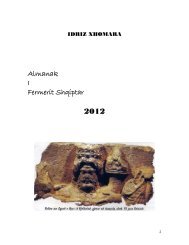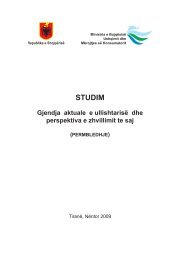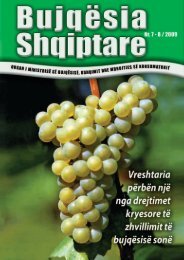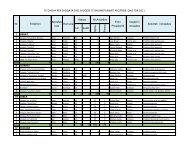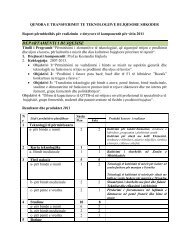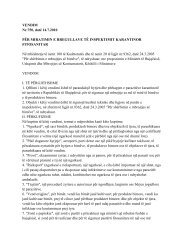MEAT Sector Analyse
MEAT Sector Analyse
MEAT Sector Analyse
- TAGS
- sector
- analyse
- mbumk.gov.al
You also want an ePaper? Increase the reach of your titles
YUMPU automatically turns print PDFs into web optimized ePapers that Google loves.
Meat <strong>Sector</strong> Study<br />
Financing for agricultural investment projects almost cannot be obtained from commercial<br />
banks, as land ownership and title are not always secure and banks are generally not much<br />
interested in agricultural land as collateral. Furthermore interest rates are high so that<br />
financing is brought up within the family, in case that there are investment projects at all.<br />
The cooperation between farmers, which is starting slowly in advanced countries like Austria,<br />
hardly exists in Albania. In the previous system farmers have been forced to cooperate and<br />
now farmers are staunchly independent, even though they could farm more profitably if they<br />
work together. Suggestions for cooperation could start in division of labour or specialising the<br />
cattle farms; one produces calves and the other one specialises in fattening them.<br />
Cattle, especially from subsistence farms, have usually no open yard and graze in the<br />
neighbourhood of the farm (and along the streets), regardless of the ownership of the land:<br />
Albania has around 423,000 ha of pastures and around 38 % are still owned by the state.<br />
The possibilities for expansion of natural pasture are limited due to the geographical situation<br />
in Albania with substantial mountainous area. Therefore increased feed must come from<br />
improved production of fodder such as lucernes, maize and other grasses, and improved<br />
utilization of industrial by-products such as olive cake, bran and soybean meal. Maize silage<br />
is almost unknown. Forage crops are now grown on 200,000 hectares (Source: MAFCP;<br />
Statistical Yearbook 2009), or 40 % of the cropped arable land, with lucernes comprising<br />
about two-thirds of this area. Most is harvested by hand – as agricultural equipment is too<br />
expensive - and there are problems with weeds and poor storage of hay.<br />
Generally there is room for improvements – especially on the small farms - concerning<br />
forage quality, management and feeding practices and also availability of clean seed.<br />
Grazing resources including pasture, forest, and some agricultural land are fundamental for<br />
livestock raising, but have degraded significantly over the last 20 years, particularly in land<br />
close to communities where over-grazing and over-cutting of wood have resulted in reduced<br />
productivity and soil erosion. (Source: SHUNDI, Andrea Prof.: Country Pasture/Forage<br />
Resource Profiles Albania; 2006)<br />
Bigger farms are managed better but have to purchase partly fodder from the market as<br />
farms are often too small to produce enough forage; that might start even with hay.<br />
Due to the small size of the herds biogas facilities are not in place.<br />
Governmental policy aims to stimulate just milk cow farmers. There is no support for meat<br />
production. Veterinary services are available to limited amount; actually only 61 % of the<br />
cows are artificially inseminated; one third of the Holstein and Jersey cows is inseminated<br />
with meat breeds such as Limousin and Charolais exclusively for meat production.<br />
Summarizing one might say that cattle farmers producing meat are oriented towards the<br />
fresh market, as imported deep frozen beef is much cheaper and therefore the meat<br />
processing industry is not interested in local beef.<br />
Cattle usually do not reach more than 420 – 460 kg live weight and average price therefore is<br />
Lek 320 -330 / kg.<br />
Sheep and goats<br />
55.942 of all farms in Albania keep sheep and 26.175 keep goat; the majority of sheep farm<br />
also keeps goats. The total number of sheep is almost constant; 1.830.000 in 2006,<br />
1.853.000 in 2007 and 1.768.000 in 2009; the number of milked sheep is always around<br />
400,000 lower. Figures for goats look as follows: 940.000 in 2006, 876.000 in 2007 and<br />
772,000 in 2009; the number of milked goats is always around 200,000 lower.<br />
Meat <strong>Sector</strong> Study, page 16



